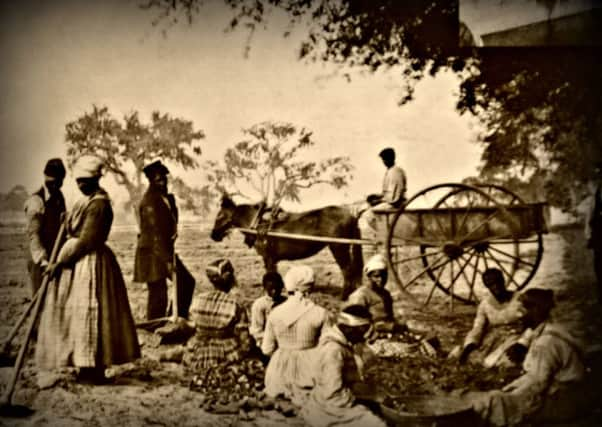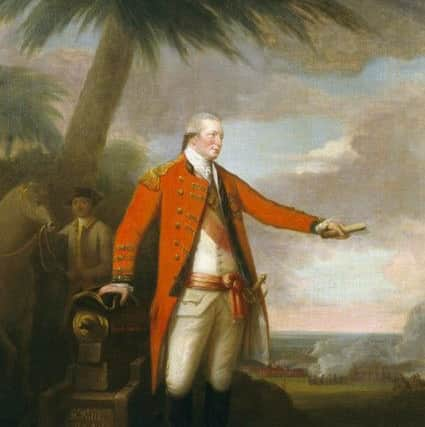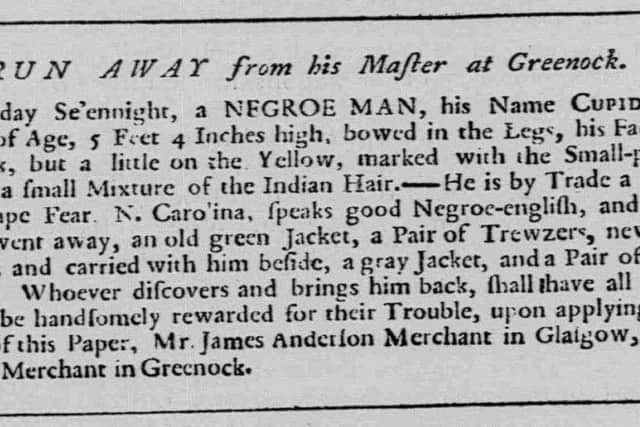Escape from bondage '“ slaves who fled Scots masters


An advertisement placed in the Caledonian Mercury in August 1756 seeking the return of Cupid reads like a wanted poster, with the runaways thought of as not only a personal affront to their master but also a valuable loss of property.
Described as about 25 years old, with a pockmarked face and bowed legs, Cupid was wearing an old green jacket, new shoes and carried a pair of “cheque trewsers” when he disappeared.
Advertisement
Hide Ad“Whoever discovers and brings him back, shall have all charges paid and be handsomely rewarded for their trouble,” the advertisement read.


No one knows what happened to Cupid after he left Greenock but research at Glasgow University has given new insight into the “significant” number of slaves brought to Scotland – and by whom.
At least 67 advertisements similar to the one printed in the search for Cupid, who was owned by Greenock merchant John Rae, were placed in Scottish newspapers during the 18th century, according to the Runaway Slaves project.
Nelson Mundell, PhD candidate on the project, said: “The vast majority of people know that slavery existed in the British Empire, most notably the North American and Caribbean colonies, but many people don’t realise that there was a significant number of enslaved on our own shores too.
“Some were brought to Scotland by merchants and traders involved in the transatlantic slave trade; others by plantation owners returning home after making their money overseas. Also, it was not unusual for retired military and naval officers, who had purchased slaves while on duty in the colonies, to return home with them.”


In February 1748, a young man called Cato ran away from the home of Colonel McDowall of Castle Semple, Renfrewshire.
Advertisement
Hide AdMcDowall, who inherited a vast commercial empire in sugar and rum in Nevis and St Kitts, went on to serve the area as a MP.
In a newspaper notice printed in the search for Cato, it said: “It is earnestly desired that no person may entertain him, as he has left his master’s service without any just cause.”
Advertisement
Hide AdColonel Munro of Novar, Ross-shire, an MP for Inverness Burghs for more than 30 years from 1768, lost his slave, Caesar, a cook from the East Indies, following his escape in June 1771.
Munro warned in his advertisement that any master of ships found carrying off Caesar would be prosecuted. The notice added: “If the slave himself shall return to his Master’s service, his offence shall be forgiven.”
A searchable database of the runaway notices has now been launched with the advertisements quite often the only evidence of the slaves who tried to flee their masters. The resource covers the whole of the UK, with more than 800 notices held
Mr Mundell added: “Unfortunately, for the vast majority of runaways we have no idea what happened after the advertisements were placed – often these notices are the only evidence of their existence.”
Slaves brought to Scotland after 1777 won new rights and protection after Joseph Knight, who was taken from Jamaica to Perthshire by Sir James Wedderburn, took his master to court. The Court of Session ruled that slavery was not recognised in Scots law and that ‘fugitive slaves’ would be protected by the courts if they wished to leave their master.
The case of Joseph Knight, and the stories of two other slaves brought to Scotland, will feature in a new graphic novel by Warren Pleece.
Advertisement
Hide AdFreedom Bound will be published later this year with funding secured by the project to provide a class set to every state secondary school in Scotland.
It is hoped that the Runaway Slaves project will attract more money to allow research to continue on those who tried to escape their masters on these shores.